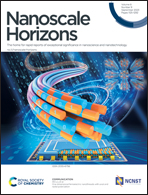Colloidal synthesis of the mixed ionic–electronic conducting NaSbS2 nanocrystals†
Abstract
Solution-based synthesis of mixed ionic and electronic conductors (MIECs) has enabled the development of novel inorganic materials with implications for a wide range of energy storage applications. However, many technologically relevant MIECs contain toxic elements (Pb) or are prepared by using traditional high-temperature solid-state synthesis. Here, we provide a simple, low-temperature and size-tunable (50–90 nm) colloidal hot injection approach for the synthesis of NaSbS2 based MIECs using widely available and non-toxic precursors. Key synthetic parameters (cationic precursor, reaction temperature, and ligand) are examined to regulate the shape and size of the NaSbS2 nanocrystals (NCs). FTIR studies revealed that ligands with carboxylate functionality are coordinated to the surface of the synthesized NaSbS2 NCs. The synthesized NaSbS2 nanocrystals have electronic and ionic conductivities of 3.31 × 10−10 (e−) and 1.9 × 10−5 (Na+) S cm−1 respectively, which are competitive with the ionic and electrical conductivities of perovskite materials generated by solid-state reactions. This research gives a mechanistic understanding and post-synthetic evaluation of parameters influencing the formation of sodium antimony chalcogenides materials.

- This article is part of the themed collections: Nanoscale Horizons Emerging Investigator Series, Nanoscale Horizons Most Popular 2023 Articles and Nanoscale and Nanoscale Horizons: Nanoparticle Synthesis


 Please wait while we load your content...
Please wait while we load your content...